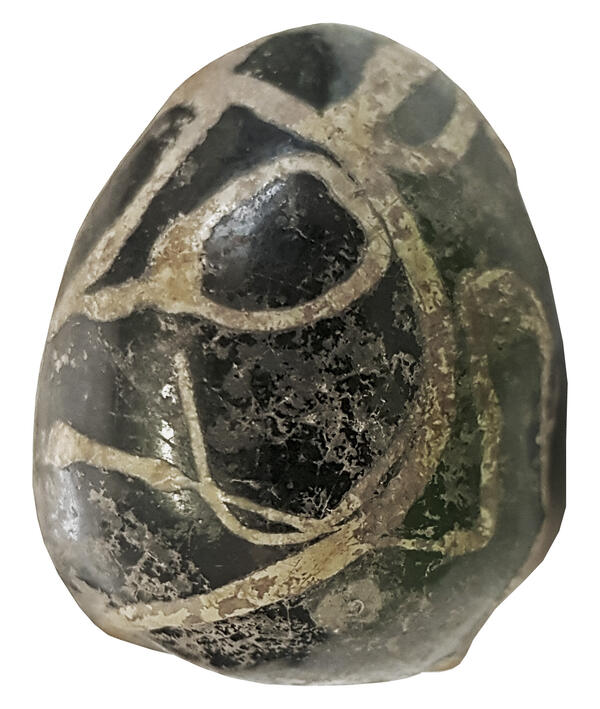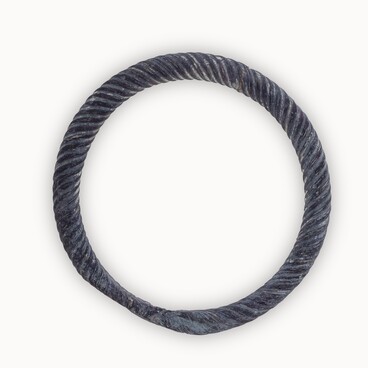The Kursk Regional Museum of Archaeology houses a pysanka, found during excavations of the settlement of the ancient Russian town of Kursk by the archaeologist Vladimir Vasilievich Enukov. Pysanki are the clay hollow Easter eggs, decorated on the surface with a glazed pattern. Such eggs are found by archaeologists during the excavations of Old Russian settlements.
Old Russian pysanka eggs are usually dated to the 11th — 13th centuries. Most of them belong to the 11th — first half of the 12th century. Outside Ancient Rus’, such Easter eggs are found in Poland, as well as in the area between the lower Elbe and Oder rivers. In medieval Christian symbolism, the egg was associated with the Resurrection of Christ. Decorated and painted eggs on Easter were hung in churches and homes, they were exchanged at the Easter Greetings, were given to family and friends. Eggs were often painted red, as a symbol of the rebirth of believers “through the blood of Christ”. It is possible that clay Easter eggs, found in some Old Russian burials, are also connected with the theme of the resurrection of the dead.
According to the archaeologist and cultural historian Tatiana Ivanovna Makarova, Easter eggs were made from ordinary pottery clay. When modeling, a clay ball or a pebble was placed inside the pysanka. A hole was often made at the back of the piece. After firing, the egg was covered with opaque brown or green glaze. Next, painting was applied in glaze of a different color. Finally, the egg was heated in the oven to ensure that the glaze melted with the surface.
Tatiana Makarova divides pysanka eggs into two groups according to the technological features of glazing. One group consists of pysanka eggs with green or chestnut-brown glazed surface, painted with intermittent and wavy yellow or light green brackets. Such pieces are generally associated with the Dnieper region and its adjacent lands. They were possibly produced in Kiev. Eggs of the second group have a black surface, characterized by metallic luster, and a more clear and perfect pattern. Such pysanka eggs were made starting from the middle of the 11th century in Novgorod, where both beads and dishes covered with glaze with metallic luster can be found. They were common mainly in the northern lands of Russia. The museum exhibit belongs to the second group. Pysanka eggs of this type were also found in Vyshgorod, Vshchizh and Belaya Vezha — Sarkel. It is possible that these crafts were also produced in Ryazan, where a kiln for firing glazed pottery was examined and fragments of pysanka eggs were found on its floor.
Old Russian pysanka eggs are usually dated to the 11th — 13th centuries. Most of them belong to the 11th — first half of the 12th century. Outside Ancient Rus’, such Easter eggs are found in Poland, as well as in the area between the lower Elbe and Oder rivers. In medieval Christian symbolism, the egg was associated with the Resurrection of Christ. Decorated and painted eggs on Easter were hung in churches and homes, they were exchanged at the Easter Greetings, were given to family and friends. Eggs were often painted red, as a symbol of the rebirth of believers “through the blood of Christ”. It is possible that clay Easter eggs, found in some Old Russian burials, are also connected with the theme of the resurrection of the dead.
According to the archaeologist and cultural historian Tatiana Ivanovna Makarova, Easter eggs were made from ordinary pottery clay. When modeling, a clay ball or a pebble was placed inside the pysanka. A hole was often made at the back of the piece. After firing, the egg was covered with opaque brown or green glaze. Next, painting was applied in glaze of a different color. Finally, the egg was heated in the oven to ensure that the glaze melted with the surface.
Tatiana Makarova divides pysanka eggs into two groups according to the technological features of glazing. One group consists of pysanka eggs with green or chestnut-brown glazed surface, painted with intermittent and wavy yellow or light green brackets. Such pieces are generally associated with the Dnieper region and its adjacent lands. They were possibly produced in Kiev. Eggs of the second group have a black surface, characterized by metallic luster, and a more clear and perfect pattern. Such pysanka eggs were made starting from the middle of the 11th century in Novgorod, where both beads and dishes covered with glaze with metallic luster can be found. They were common mainly in the northern lands of Russia. The museum exhibit belongs to the second group. Pysanka eggs of this type were also found in Vyshgorod, Vshchizh and Belaya Vezha — Sarkel. It is possible that these crafts were also produced in Ryazan, where a kiln for firing glazed pottery was examined and fragments of pysanka eggs were found on its floor.



